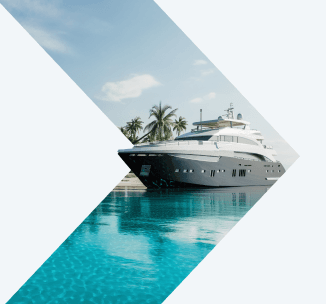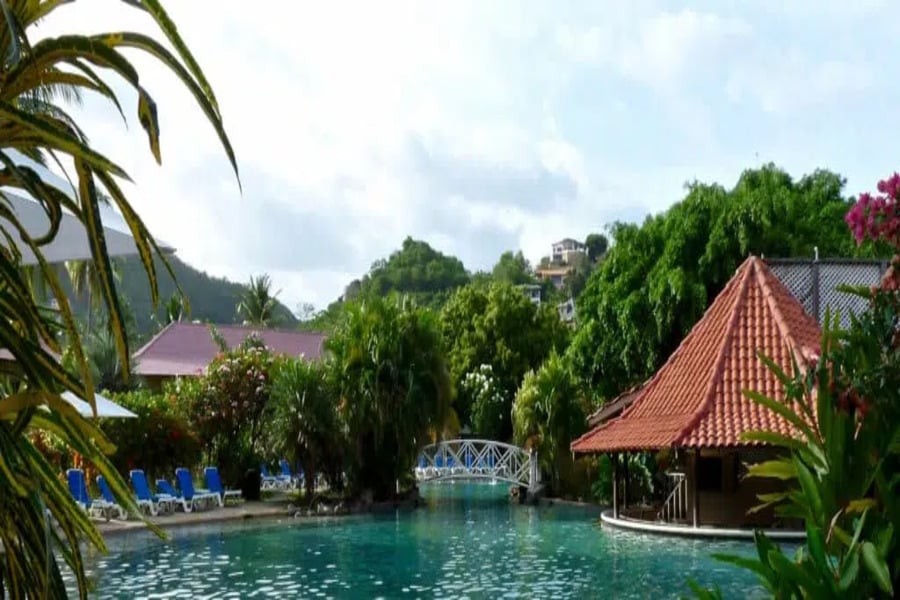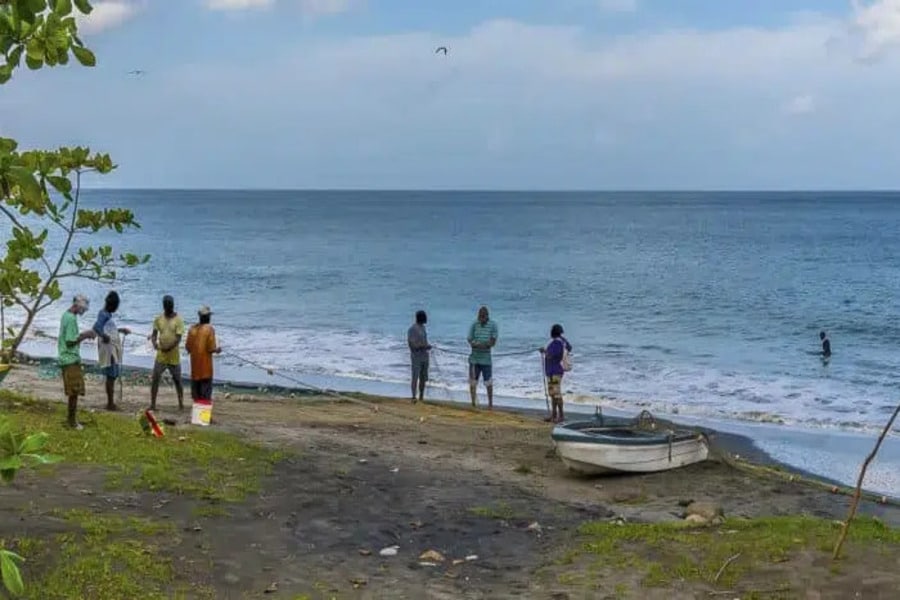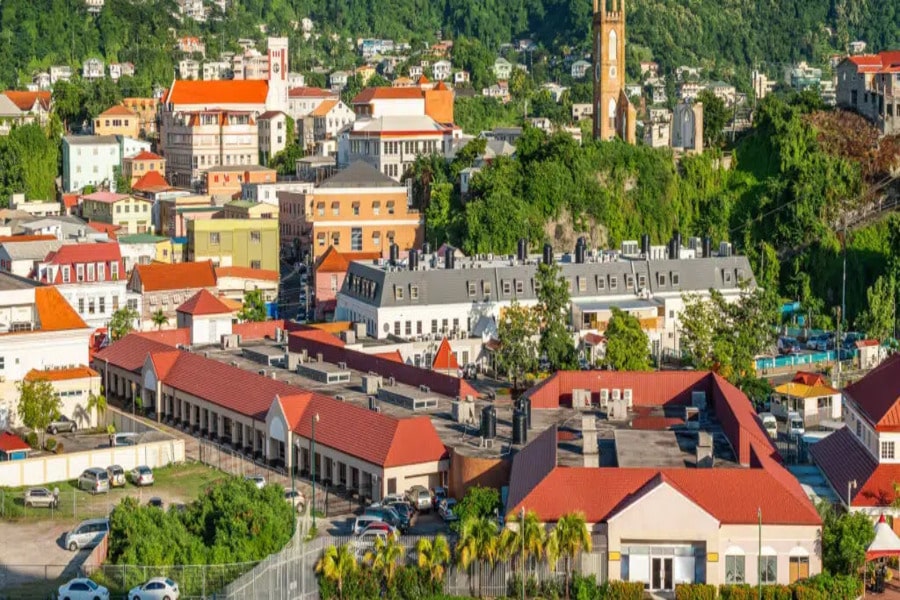Caribbean Island of Grenada: Interesting Facts about the Country
Grenada is an island nation in the Caribbean. The country's economy is developing through tourism services, agriculture and investments from the citizenship program.
Cosmopolitans acquire Grenadian citizenship to travel freely to 146 countries, including the Schengen area, UK, China and Singapore. We will tell you where Grenada is located, how the local population lives, how much it costs to relax on the islands and what to see in the country.

Head of the Austrian office
Fact checked byPaul Lauber
Reviewed byVladlena Baranova

Caribbean Island of Grenada: Interesting Facts about the Country
Share:
Facts about Grenada
Where is Grenada located?
Grenada is located in the southeastern part of the Caribbean Sea and occupies the island of the same name and part of the southern islands of the Grenadines. The largest islands are Grenada, Carriacou and Petite Martinique. The other four are uninhabited. All islands are part of the Lesser Antilles archipelago.
The capital of Grenada is the city of St. George's. It is located on the southwest coast of the island. The capital has the largest port in the country and an international airport.
Grenada's closest neighboring countries are Venezuela, Trinidad and Tobago, Saint Vincent and the Grenadines.
How to visit Grenada
Foreigners can get to Grenada by plane or cruise ship, which depart from Europe or America. Tourists usually fly with transfers in the USA, Europe and other Caribbean countries. The time difference between the capitals of Moscow and Greenwich is five hours.
Ticket prices depend on the season and the number of connections: the cost of a flight in August 2021 starts from $550. This is the price of a connecting flight in New York.
Cruises depart from Europe or America: travel time depends on the route and varies from one day to three to four months. Ticket prices start at $300 per night.
At the border, it is required to show an international passport, a returnicket, a hotel reservation or a tourist voucher. You also need documents that confirm your solvency. For example, credit cards and checks with the account balance.


Are you a perfect fit for Caribbean citizenship?
Discover your eligibility with our simple quiz!
History of Grenada
The island of Grenada, like several other Caribbean islands, was discovered by Christopher Columbus in 1498. During his third trip to the New World, he landed on the island and named it in honor of the Immaculate Conception of the Virgin Mary – “La Concepcion”.
The origin of the name "Grenada" is still not clear in Grenada history. One of the versions is that the Spanish sailors renamed the island in honor of the Spanish city of Granada, and then the French and British transformed it into Grenada.
The French and British fought for the right to colonize Grenada for 150 years after its discovery. In 1672, the French military gained control of the island. A hundred years later, the war began again, in which the British won. Grenada became part of the Leeward Islands, an English colony.
In the 18th century, the British established sugar plantations on the island, for which slaves were brought from Africa to work. In the late 18th century, hurricanes destroyed the sugar fields. They were sown with new crops of cocoa, cotton and nutmeg introduced by Europeans.
In 1967, the country became a self-governing state with the UK. Then finally, on February 7th, 1974, Grenada gained independence as part of the British Commonwealth of Nations.
Geography and nature of Grenada
Geography. The Grenada island is of volcanic origin. In the center of the island there is a mountainous relief, the highest point of the country is 840 meters above sea level. The islands of Grenada are well positioned relative to the other Lesser Antilles, so hurricanes cause less damage than in other Caribbean countries.
In the plains between the mountains are the spice plantations which Grenada is famous for. The inhabitants of the country reap a large harvest every year thanks to the fertile soil of volcanic origin. At the foot of the mountains, hot springs and mineral lakes have formed, where anyone can swim.
The climate in the country is tropical with trade winds. The rainy season begins in May and lasts for around six to seven months. In January, no more than three tropical showers occur in a month. The temperature on the island is stable and rarely drops below +20°C.

Grenada is divided into six parishes. The country also includes the islands of Carriacou and Petite Martinique. Most of the population lives in the capital city of St. George’s and in the major cities of Grenville, St. Davids and South’s
Nature. European settlers cleared many of Grenada's forests alongside natural disasters and fires destroying many plant species. Tropical forests have been preserved closer to the tops of the mountains. The forests of the island are protected and are part of the Grand Etang National Park. Mangroves are also found along the coast.
Many species of mammals have disappeared on the islands but the monkeys and mongooses, which were brought from Asia in the 18th century, took root. The forests are home to about 150 species of birds, including the endangered species, e.g. the Grenada dove, which is found only in Grenada. About 400 species of fish are found off the coast of the island. Most often, local fishermen catch tuna, snapper and mahi mahi.

The Grand Etang National Park is located in the central part of Grenada. On its territory are the Annandale and Seven Sisters waterfalls, as well as several extinct volcanoes, in the crater of which lakes were formed
Vacation in Grenada
The most comfortable months for travel to Grenada are from January to May. At this time, the rainy season has already ended and the islands are calm.
Accommodation. On vacation, tourists stay in hotels in Grenada or in rented villas, apartments and houses from local residents. The rental price depends on the region of Grenada. The average rental price for a one-bedroom apartment is around $500 per month, according to numbeo.com.

Hotels are most often located on the shores of the Caribbean Sea or the Atlantic Ocean. Vacationers can stay in a bungalow, modern eclectic home or villa with classic colonial interiors
Prices in Grenada do not differ from the prices of living in Europe or North America. Dinner for two at a mid-range restaurant will cost $74. For comparison, an average dinner in Canada will cost $75, and in the UK, $70.
For the same amount, you can independently buy groceries in the store:
-
bread, 500 g — $1.4;
-
milk, 1 l — $1.7;
-
rice, 1 kg — $1.31;
-
local cheese, 1 kg — $9;
-
eggs, 12 pcs. — $3.7;
-
chicken fillet, 1 kg — $9;
-
beef, 1 kg — $15.2;
-
potatoes, 1 kg — $2.8;
-
tomatoes, 1 kg — $5;
-
apples, 1 kg — $8;
-
bananas, 1 kg — $2.8;
-
oranges, 1 kg — $3.3;
-
a bottle of mid-range wine — $11.
A monthly gym subscription costs $50, to rent a tennis court costs $3 per hour and a movie ticket costs $9.
Infrastructure. Grenada has a developed tourist infrastructure with hotels, restaurants, sports complexes, golf and tennis clubs. Local travel agencies organize city and tropical excursions, boat and car trips around the island. Tourists can also go kayaking, diving or surfing.
There are two airports in the country, one of which is the international one named after Maurice Bishop. It is located eight kilometers away from St. George's. The second airport has flights to neighboring islands such as Trinidad, Saint Vincent or Barbados.
The islands of Grenada are popular with yachtsmen and sailors from all over the world. In the bays and lagoons of the Caribbean Sea, there are marinas with docks, repair services, restaurants and hotels.
Port Louis Marina is one of the largest marinas in Grenada, located in the southwest of St. George's. The marina has 170 berths that can accommodate ships of all sizes. Yachtsmen often dock at Clarkes Court Bay Marina and Le Phare Bleu Marina, as well as local hotels, which usually have their own marinas. For example, a marina of the same name is open at the Prickly Bay Waterside resort.

In large cities of the country, most of the buildings are built in the colonial English style. Due to possible hurricanes, houses in cities are rarely built above three stories
Transport. The settlements of Grenada are connected by bus routes; a ticket costs a dollar and a taxi ride will cost $15 per kilometer.
If you wish, you can rent a car and explore the island on your own. Traffic in the country is left-hand, there are asphalt and dirt roads. To travel around the islands, you will need an international driving license.
There is a ferry service between the islands of Grenada Caribbean, Carriacou, Petite Martinique and Saint Vincent. Ferry fares depend on the season.
Attractions and events
The life and culture of the inhabitants of Grenada was influenced by the French and British colonialists. The buildings in the cities are built in the classical style of both countries, and the names of the cities and streets bear European names.
The mentality of the island's inhabitants is also shaped by the customs of their ancestors: Arawaks, Caribs and Africans.
Sights. Saint George’s, the capital of Grenada, is a city with colonial architecture. Buildings built by the French in the 17th and 18th centuries have survived there. Also in 1710, the French erected the country's first fort, Fort Royal, which is now called Fort George. And by 1800, four more forts were built on the island: Lucas, Adolph, Matthew and Frederick.
The main harbor is the Carenage in St. George’s, the harbor is shaped like a horseshoe. There are always many ships, yachts and schooners at the harbor berths. Port Frederick is located at the eastern entrance of the harbor.
On the islands of Grenada, there are about 50 beaches, where people go to swim in warm water, sunbathe on the black volcanic sand and sit in admiration. The most popular are Mo e Rouge, La Sagesse and Grand Anse. The first beach is adored by locals. The shade from the trees provides coolness, and it is also a convenient place to have barbecues and picnics.
La Sagesse is a secluded beach with coconut palms and tropical trees. Most tourists rest on the Grand Anse beach: there are many restaurants, shops and sea equipment rentals on its territory.
The first underwater sculpture park was opened off the coast of Grenada: 65 sculptures are displayed at a depth of 10 meters, which function as artificial reefs.
Tourists come to the island to see the St. Catherine stratovolcano and the Seven Sisters waterfall. It consists of seven cascades, along which water falls in a calm stream. Anyone can swim in the reservoir next to the waterfall.

On the way to the Seven Sisters cascading waterfall, tourists can see plantations of cocoa, bananas and nutmeg, as well as rare animals and birds of the island, e.g. the Grenada dove
Events. On February 7th, the whole country celebrates Independence Day. The islanders come together for the Grenada ca ival holding ceremonies and parades in which Boy Scouts and the Royal Grenada Police take part.
Local athletes invented and organized their own regatta, Grenada Sailing Week. It starts in late January and early February and lasts for eight days.
Once a year, the Grenadians organize the Spice Island Billfish Tou ament, a fishing tournament. In the mo ing there is a boat parade, and in the evening there is a celebration in honor of the largest fish caught in the day.
Grenada is called the island of spices, and in 2021 the World Food Travel Association recognized the country as the culinary capital of the Caribbean. The country grows to export nutmeg, cinnamon, cloves and cocoa, as well as various vegetables and fruits.
Tourists can taste authentic seafood dishes at local restaurants. Almost every café's menu includes the oil down, Grenada's national dish. This is a chowder made from breadfruit, coconut milk, turmeric, taro leaves, dumplings, salted cod meat, or beef jerky.
In Grenada, beer and wine are brewed, in honor of which the Uncorked Beer and Wine Fest is held. It takes place in May: visitors can taste different types of wine and beer for free and buy their favorite.
In April, the Carriacou Maroon & String Band music festival takes place on Carriacou Island. It features local bands and artists. Residents perform rituals and celebrations, followed by smoke fish to the sound of drums.
Everyone who loves to read gathers at the Spice Word literary festival. This is one of Grenadians favorite holidays, which takes place in October and is sponsored by the locals.

Local fishermen invent fishing competitions and tournaments, some of which escalate into national holidays, such as the Spice Island Billfish Tou ament
How to obtain Grenada citizenship and what it gives investors
The Grenada State Citizenship by Investment Program was launched in 1997. Investors make a non-refundable contribution to the National Transformation Fund or buy real estate from a government-approved list of properties.
Together with the investor, citizenship is obtained by his family members: spouse, children under 30 years old, parents, grandparents, brothers and sisters over 18 years old.
Grenada's passport allows investors to travel freely to 146 countries. Grenadians do not need visas to travel to the Schengen states, the European Union, the United Kingdom, China and Singapore.
Citizens of Grenada can obtain an E-2 business visa in the United States. Other Caribbean residents and the majority of citizens of other countries do not have this opportunity. E-2 is a nonimmigrant visa but it allows the holders to live in the United States, work and study in the country.
The minimum investment for an E-2 visa has not been determined. An investor needs to invest a significant amount in his company, usually an investment of $200,000 or more is enough. Obtaining a visa takes two to five months.
Grenadians can obtain a tourist visa to the United States for ten years under a simplified procedure.
The Grenada Citizenship by Investment Program has been in operation since 1997. You don’t need to visit Grenada to get a passport as the process is remote. During the pandemic, application processing begins as soon as scanned copies of documents are received by the department.
The cost of obtaining a Grenada passport is two to three times less than for investment programs of a residence permit in European countries. The term for obtaining citizenship is from four to six months. Under the terms of the program, the applicant chooses between two investment options.
Investment options of the Grenada citizenship program
-
Non-refundable contribution to the National Transformation Fund — the investment amount is $150,000+.
-
Purchase of property — the investment amount is $220,000+.
In addition to investments, the applicant pays state fees, administrative fees, and also pays for due diligence and paperwork. The total amount depends on the age and family composition of the investor.
Real estate in Grenada
Foreigners can buy a villa, apartment or land plot to live with their family or to rent it out. Real estate prices depend on its location and the type of building. According to numbeo.com, the average cost of a 1m2 city apartment is $3,000.
Investors who want to obtain Grenadian citizenship can buy real estate to participate in the program. However, they need to choose an object that has been approved by the government of the country. These are mainly apartments, villas and stakes in hotel complexes.
In addition to the amount of investment, the investor pays for state duties, fees, Due Diligence, services for registration, translation and legalization of documents. The total amount depends on the composition and age of the family members.
Examples of properties in Grenada
Life in Grenada
Population. The bulk of the Grenada population is of African descent. The islands are also home to the descendants of the Arawak and Caribbean Indians mixed with a small percentage of Europeans. The official language of the country is English, but residents more often use Creole, derived from French.
Religion. Approximately 96% of Grenadians are Christian: Roman Catholic, Anglican, Presbyterian, Methodist, Christian and Baptist churches operate on the islands. Some of the islanders adhere to the teachings of Seventh-day Adventists, Jehovah's Witnesses, Mennonites, and Pentecostals.
About 2% of the population profess folk beliefs, 1% — Hinduism and Islam and another 1% of residents call themselves atheists.

Saint George’s, capital of Grenada, is named after the Church of Saint George, which was one of the first buildings built on the island
Taxes. Citizens of Grenada do not pay taxes on wealth, capital gains, inheritance and gifts. Residents of the country do not pay tax on income and capital received in other countries.
Taxes for individuals
Taxes for legal entities
Education. The educational system of Grenada is modeled on the British one. There are 120 preschool institutions, 23 schools, one college and three universities in the country.
Children from 6 to 14 years old are required to attend primary and secondary schools. Education in public schools is free. The government gives all textbooks to schoolchildren and provides them with food.
School graduates can continue their studies at a technical university, at a branch of the University of the West Indies or at the private University of St. George's.
The University of St. George’s is one of the most renowned universities in the Caribbean. The history of the university began with the opening of a medical school in 1976.
Now students are also studying in the faculties of international business, art and science and postgraduate education. Students of this university undergo practical training in the United States, and the diploma is recognized in 47 countries.
Medicine. There are six hospitals and about 30 private clinics in Grenada, including the offices of family doctors, dentists, and ophthalmologists. Most of the nursing staff are graduates of the University of St. George's.
Therapists and cosmetologists are welcome in almost every major hotel. In severe cases, tourists are hospitalized in clinics. Treatment for non-residents is paid, so before the trip you need to take out insurance.
Political and economic structure of Grenada
Political structure. Grenada is a constitutional monarchy. The head of state is officially considered the reigning monarch of Great Britain. The interests of the monarch on the islands are represented by the gove or-general.
Laws of Grenada. Legislative power in the country is exercised by the parliament. It consists of a Senate and a House of Representatives. Executive power rests with the Cabinet of Ministers, which includes the Prime Minister, Ministers and the Attorney General.
Grenada's judicial system is part of the Eastern Caribbean judicial system, which is chaired by the Eastern Caribbean Supreme Court. On the territory of the country there are local courts and the High Court, which simultaneously performs the functions of the Constitutional Court. Judges are appointed by the Governor-General on the recommendation of the Judicial Commission and the Legal Service.
Official websites of Grenada authorities

The Grenadian flag was adopted in 1974 after the War of Independence. The flag was designed by local artist Anthony George. The flag symbolizes trust, hope and expectation of a better world for the population of the country
The country's economy is dependent on tourism, agriculture and foreign investment, most of which comes from the citizenship program. Income to the treasury also comes from shipbuilding, fishing and private education.
A large number of fish, in particular yellowfin tuna, are exported to the United States and Europe. Grenada brews beer, produces flour and animal feed for export. Local companies manufacture and sell furniture from exotic trees, which are popular in European countries.
The Grenada Citizenship Program has been in operation since 1997. The income from the program is used to improve infrastructure, develop the tourism industry and help the population.
Immigrant Invest is a licensed agent for citizenship and residence by investment programs in the EU, the Caribbean, Asia, and the Middle East. Take advantage of our global 15-year expertise — schedule a meeting with our investment programs experts.

Practical Guide
Will you obtain Grenada citizenship?
Master the residency process
Get expert tips and documents
Estimate costs accurately


















